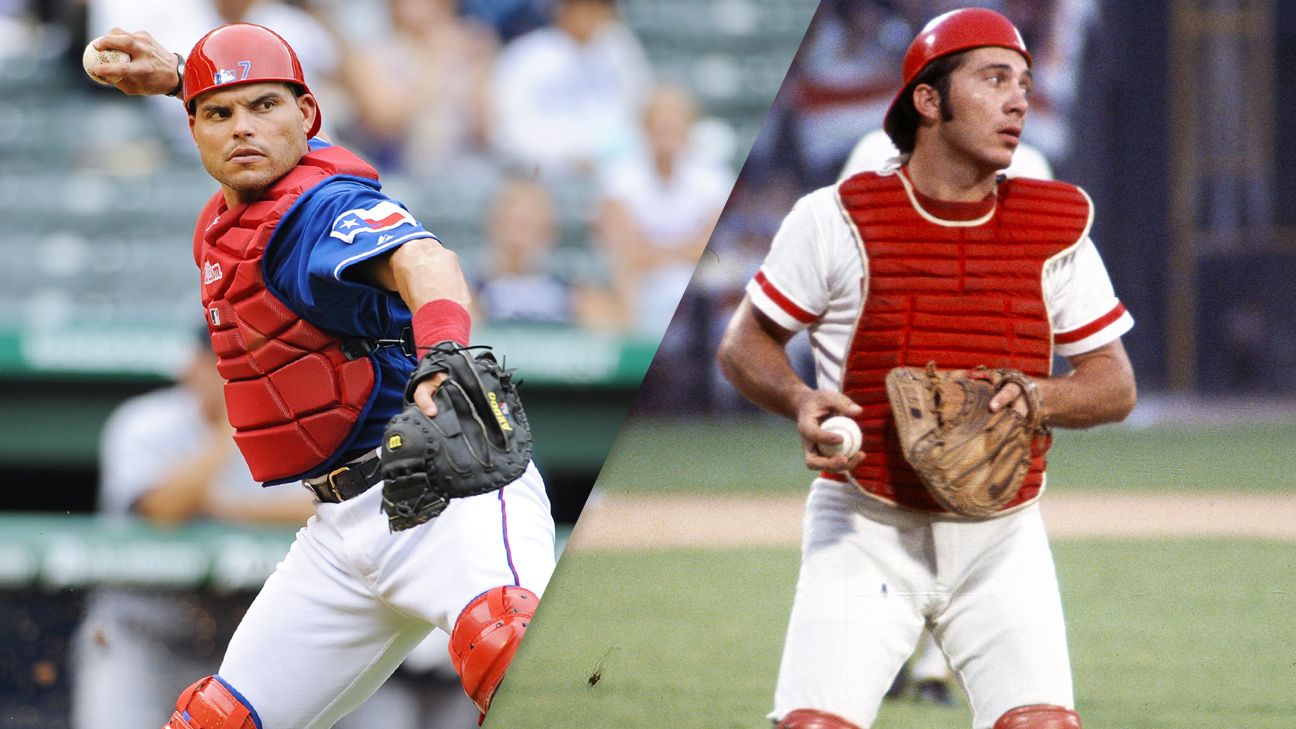 “I don’t want to embarrass any other catcher by comparing him to Johnny Bench.” — Sparky Anderson
“I don’t want to embarrass any other catcher by comparing him to Johnny Bench.” — Sparky Anderson
The legend of Johnny Bench began when he was still 18 years old and playing for Class A Peninsula in the Carolina League. When it was announced late in the season that he was getting promoted to Triple-A Buffalo, the team held a pregame ceremony and retired his uniform number. Everyone knew Bench was special, including Bench. The story goes that when he was called up to the majors, still just 19, he announced to the clubhouse that he didn’t come up to be the backup catcher.
During his rookie season in 1968, reports already were glowing about Bench’s potential.
“The question isn’t how good a catcher 20-year-old Johnny Bench is,” began an AP story in July, “but how great he will become.”
Giants manager Herman Franks said Bench already was the best catcher in the National League since Gabby Hartnett in the 1930s.
“With more experience, he could be the best the league has ever had,” Franks said.
Ivan Rodriguez also reached the majors at 19 after a short minor-league apprenticeship (Bench played 265 games in the minors, Rodriguez 271). With his rocket arm and quickness around the plate, he immediately was compared to Bench defensively and it wasn’t embarrassing. Bench won a Gold Glove his rookie season and Rodriguez won one his first full season in the majors. Bench would end up winning 10 of them, Rodriguez 13.
Rodriguez is on the Hall of Fame ballot for the first time and has a chance to get in: He’s got 81 percent of the votes that have been made public, which probably will put him right near the 75 percent barrier to get elected when all votes are counted. It raises the question: Is it possible to construct an argument in favor of Rodriguez as the greatest catcher ever?
Bench is the consensus choice as best ever, although in “The New Bill James Historical Baseball Abstract,” published in 2003, Bill James rated Yogi Berra ahead of Bench (Rodriguez was midway through his career at the time). In career Baseball-Reference WAR, Bench holds the edge:
Bench: 75.0
Gary Carter: 69.9
Rodriguez: 68.4
Carlton Fisk: 68.3
Berra: 59.5
Mike Piazza : 59.4
Leaving aside Berra and Carter for now, the argument for Rodriguez over Bench rests on two factors: defense and longevity. This is because Bench was the superior offensive player, although their career numbers look similar:
Bench:.267/.342/.476, 389 HR, 1376 RBIs, 1091 R, 126 OPS+
Rodriguez: .296/.334/.464, 311 HR, 1332 RBIs, 1354 R, 106 OPS+
Rodriguez played in an era when more runs were scored, so the runs he created weren’t as valuable. Baseball-Reference estimates Bench created 269 runs more than the average hitter over his career, Rodriguez 74. In Offensive WAR, which includes a positional adjustment, Bench rates at 65.2 wins above replacement and Rodriguez at 53.9. Rodriguez hit for the higher average, but was an aggressive hitter, didn’t walk much and grounded into a lot of double plays. Bench had more power (11 20-homer seasons compared to five for Rodriguez) and was better relative to his league.
So Rodriguez has significant ground to make up on defense. Bench was a game-changer behind the plate. He was one of the first catchers to start receiving the ball one-handed, using a hinged catcher’s glove, instead of the traditional two-handed style. His throwing arm obviously impressed even the old-timers. There are quotes about his quickness in applying tags at home plate, similar to how we read about Javier Baez this past season with his tags at second base. Bench’s athleticism was on display when Anderson often played him in the outfield to give him a break from catching.
I didn’t see the young Bench, but I saw the young Rodriguez, and his arm received the same awe-inspiring commentary. The arm strength did seem to be at another level compared to any other catcher. What do the numbers say? Bench led his league three times in caught stealing percentage, Rodriguez nine times. For their careers, Bench had a 43 percent caught stealing rate against a league average of 35 percent. Rodriguez had a 46 percent caught stealing rate against a league average of 31 percent (he was over 50 percent the first half of his career).
Worth noting as well: When Rodriguez joined the Rangers in 1991, they had a staff with a reputation of not holding runners on — Nolan Ryan, for example, was one of the worst ever at that. In 1989 and 1990, the Rangers allowed the second-most steals in the American League (140 and 131, respectively). In 1992, Rodriguez’s first full season, they allowed the fewest with 87 (with a 49 percent caught stealing rate). It’s possible the defensive metrics actually are underrating Rodriguez’s value in controlling the running game.
But Bench also shut down the opportunities against him. In 1970, the National League average was 87 steals per team; the Reds allowed just 46. In 1972, the league average was 80 steals; the Reds allowed just 31. Bench hurt his shoulder in 1975 and runners were more aggressive on him after that, but consider this fear factor: From 1970 to 1976, the Reds played 42 postseason games and Bench allowed just two stolen bases while nailing 13 would-be thieves. Meanwhile, he stole six bases in seven attempts. He stole more bases than he allowed. Incredible.
Overall, Baseball-Reference grades Bench as 97 runs above average on defense at catcher and Rodriguez at plus-146. This doesn’t include aspects of the game like handling a pitching staff or pitch framing. Bench’s credentials in handling a staff seem impeccable; there were some comments late in his Rangers career that Rodriguez cared more about his offense, but after leaving Texas he helped the Marlins win a World Series and the Tigers reach one, so it’s hard to knock him in that category. Rodriguez probably was better at throwing out runners and certainly was better at it for longer, but even if Rodriguez receives the edge on defense, I don’t think it outweighs Bench’s advantage at the plate.
Then we have to consider longevity. Rodriguez played 20,348 innings at catcher, Bench 14,488. Rodriguez still was catching regularly at 38 while Bench last caught regularly at 32. Those 5,000 extra innings — five to six extra seasons of games — are a big plus for Rodriguez.
We can break their value down like this:
Ages 19-32
Bench: 72.8 WAR, 14,401 innings caught
Rodriguez: 59.3 WAR, 13,224 innings caught
Age 33 on
Bench: 2.2 WAR, 84 innings caught
Rodriguez: 9.






